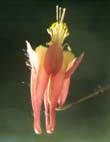|
The
total biodiversity of an area can be broken down into two hierarchical
components:
1)
The number of functional types of organisms (e.g. carnivorous
animals, Nitrogen (N)-fixing plants) or ecosystems (coniferous
forest, prairie, tundra, marine intertidal).

2)
The number of functionally equivalent organisms/ genotypes
within each functional type (e.g. the number of species of wood-rotting
fungi). These organisms perform the same role in an ecosystem
(e.g. moose and caribou are both large herbivores in boreal ecosystems;
mussels and tunicates are both sessile marine filter feeders).
(Huston, Ch.1 )

The basis for this
division is that mechanisms that drive the diversity of functional
types are different from the mechanisms that drive diversity among
functionally equivalent organisms. For example, competition plays
a significant role in determining diversity of functionally equivalent
organisms but has little influence on functional diversity in
an ecosystem. (Huston,
Ch.1)
Many other factors
will influence the diversity of a system besides competition.
These include evolutionary changes, geology, human history, environmental
variability, disturbance and random population fluctuations. (Huston,
p.76)
These factors are further
discussed in Part 3: Processes and Patterns
of biodiversity.
Ecologists
have developed ways to characterize species diversity in a given
area:
Within-habitat
diversity or alpha-diversity: refers to a group of organisms
interacting and competing for the same resources or sharing the
same environment. Measured
as # of species within a given area. (Huston
p.72; Whittaker, 1960,
1967; Fisher et al., 1943)
Between-habitat diversity
or beta-diversity: refers to the response of organisms to
spatial heterogeneity. High beta-diversity implies low similarity
between species composition of different habitats. It is usually
expressed in terms of similarity index between communities (or species
turnover rate) between different habitats in same geographical area
(often expressed as some kind of gradient). (Whittaker
1960, 1967)
Geographical diversity
or gamma-diversity (Whittaker
1960, 1972)

Reprinted
from figure 5.6 in Perlman, D.L. and Adelson, G., 1997. by permission
of Blackwell Science, Inc.
Number
of species globally
How many species are there
on Earth? There is no definitive answer . Estimates fall between 1.5 and 30 million species of plants and animals.
Another recent estimate claims that a more realistic number is 6 million.
(Dobson, 1996).
What we do know is
that between 1.5 and 1.8 million species have been identified. The majority
of species remain unidentified. Of the 34 known animal phyla, only one
phylum lives exclusively on land while 33 are found in the ocean. Of
those 33, 14 are found nowhere else on earth.
. Estimates fall between 1.5 and 30 million species of plants and animals.
Another recent estimate claims that a more realistic number is 6 million.
(Dobson, 1996).
What we do know is
that between 1.5 and 1.8 million species have been identified. The majority
of species remain unidentified. Of the 34 known animal phyla, only one
phylum lives exclusively on land while 33 are found in the ocean. Of
those 33, 14 are found nowhere else on earth.
Of the species that
have been described, approximately:
 750
000 of these are insects 750
000 of these are insects
41 000 are vertebrates

·  250
000 are plants 250
000 are plants
The remaining species are
comprised of invertebrates, fungi, algae and other microorganisms. The
biological diversity of many ecosystems remains poorly explored, even
today. These ecosystems include the deep ocean and the tree canopy and
soil of tropical forests.

For
more information on marine biodiversity, visit the Conservation
International website:
|